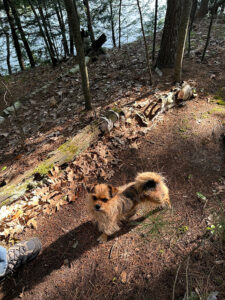This post originally appeared on Murder Is Everywhere.
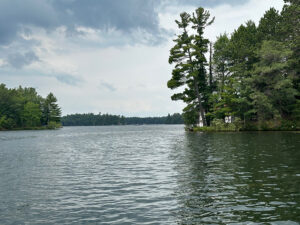
It’s just after six in the morning, and I’m sitting outside with my coffee watching a morning mist flowing across the top of Lake Kawaguesaga.
It seems like a spectacular illusion straight out of a movie’s computer animation department. But this is real, and I am here, spending a wonderful week in the cool misty climate of Northern Wisconsin. I’m fortunate to be staying with family members and even my dog, Daisy, with my friend Marcia Tingey at her longtime summer home—a place she and her husband built out of the ruins of a 1920s fishing camp house on a small island that they bought, part and parcel, and carefully brought back to habitable life. If this story sounds like it should be a summer beach book—perhaps the Wisconsin version of Under The Tuscan Sun—I agree.
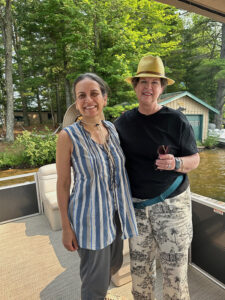
Marcia owns Fiefied Island in Lake Kawaguesaga, one of the five lakes in a scenic chain named Minocqua that are about 26 miles north of Rhinelander. The town and lake chain’s name were possibly inspired the name of a Chippewa band chief, Noc Wib, who headed the community through the 1880s. In the 1860s, U.S. government surveyors had found the lovely area, noting its lakes and beautiful old-growth forests. Chippewa people were first discovered in the area in the 1860s, when government surveyors came and saw the magnificent chain of 5 lakes, and the beautiful old-growth wood forests. Naturally, the government could not walk away from this bonanza.
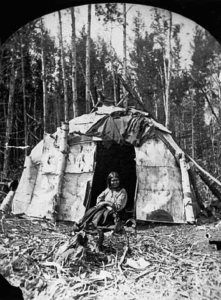
By the 1880s, the Indians were pushed out of the Minocqua region to the existing Flambeau reservation. And the lovely land became both a source of lumber and a haven for summer tourists, many of whom came on the Chicago, Milwaukee & St. Paul Railway line built in the 1880s. The original, late 1800s downtown was burned in a 1912 fire and then rebuilt for generations of tourists to come. At one time, there were hundreds of summer homes and resorts dotting the shores of the five lakes in the Minocqua chain. Today it’s still touristed, but in a low key way, with the downtown of Minocqua comprising about three blocks of souvenir shops. From a dock near downtown, Marcia can pontoon herself 8 minutes to her island home.
The island has stayed natural, with no other housing than the Tingey place, and no pavement or way of moving about except by on foot. This makes it very possible to imagine Minocqua back in the times of the Chippewa people. Pine, birch, maple, balsam and hemlock trees rise high and happy. The spongy, sandy earth is carpeted with ferns, moss and mysterious mushrooms of varying hues.
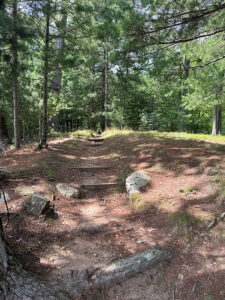
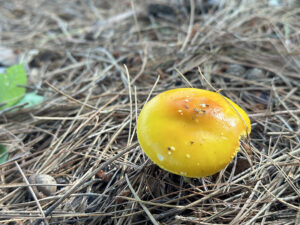
Marcia’s late husband, Jim Tingey, carved fantastical sculptures out of island wood. Jim’s mysterious beings and mushrooms are sited all over the island, along with wooden chairs placed in ideal spots for meditation and contemplation of scenery. I felt the long ago indigenous presence on the island. It’s a very special, spiritual place.
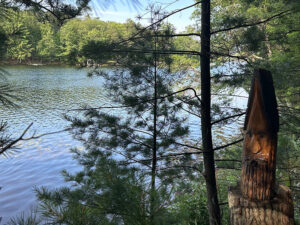
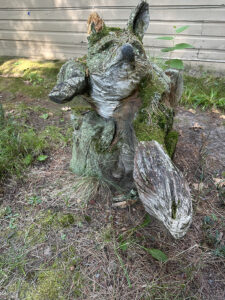
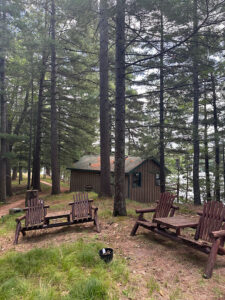
A few bald eagles live on the island; I was lucky enough to see a juvenile touch down on the path in front of me, although little Daisy regrettably barked, and the magnificent raptor flapped its wings and exited. Does nurse their fawns here before the young deer are strong enough to swim alongside their mothers to the mainland. As far as other animals go, mice, chipmunks and raccoons are present. Bears also swim. Marcia spotted a brown bear on the island four years ago, but she thinks the bear was on a walkabout and not at home. Loons have long bred and relaxed on the island’s marshy side. The waterfowl are currently absent because their protective platform broke in a storm. Marcia plans to have it rebuilt so the gorgeous waterfowl will return to their sanctuary.
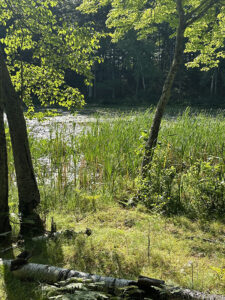
My days here have been spent walking narrow trails, looking through the tall pines at the shatteringly blue and tranquil lake Kawaguesaga, whose silence is occasionally cut by jet skis power boats. But for long spells, one can sit in utter peace.
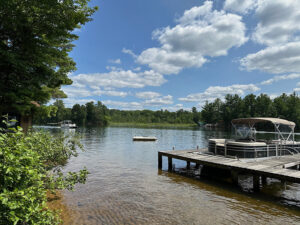
Recently I’ve longed to be more mindful: chiefly, noting what’s around me and what sensations I’m feeling. It’s been challenging for me to slow my mind and not jump off to different places. While staying here, it hit me that the practice of fiction is entirely about being in another imaginary place. Telling stories set in another time and place only escalates being inattentive to the present. It’s necessary—but it takes a toll on the writer.
Lying on the house’s deck, which was thoughtfully built to include the pre-existing tall pine growing there, I feel different. My eyes go straight up into the heart of the tree’s gorgeous crown. Or I’m sitting on the deck, watching the water’s natural slow current. After I’ve admired the lake, my eyes travel across the water to a pulsating movement in the air in front of some faraway trees. Are they a flock of thousands of insects, or hundreds of small birds? What is going on with so much energy in one place? Even Daisy, who never goes off leash, threw herself into new freedom and speed as Marcia’s dog, Blondie, showed her the way.
And that is the truth about being stuck in the woods for a week. It seems like nothing’s going on, yet the reality is you aren’t alone. Everything is alive and in some kind of growth or motion. This is the world that matters more than the noise.
